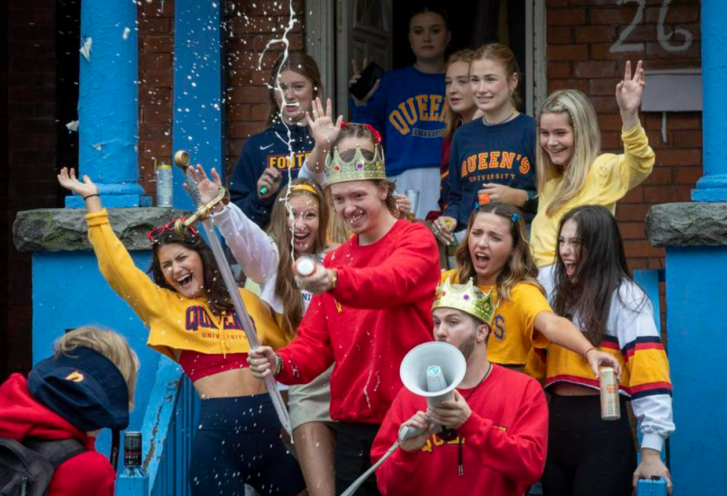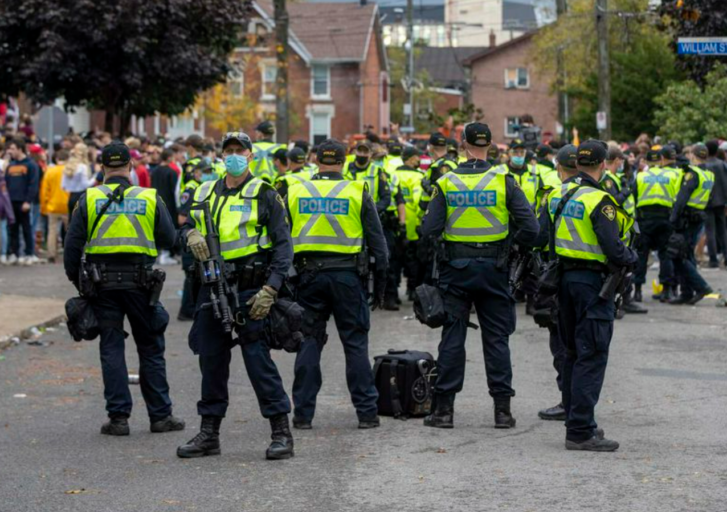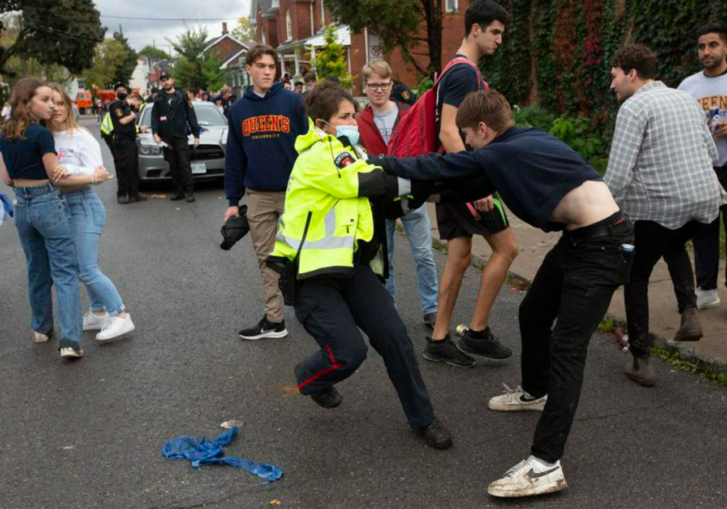KINGSTON, ONT.—For a few hours last Saturday morning, homecoming at Queen’s University was shaping into a low-key event. Lightning lit the sky, rain pelted sideways and roads were flooded.
Jack Denmo, a social media influencer who documents the antics of drunk students at events like these across Ontario and spins the material into feature-length movies for his YouTube channel, hit the University District with a small film crew. They approached Aberdeen Street, a stretch of student housing notorious for unsanctioned street parties, just before lunch.

“It doesn’t look like you’ll get enough to fill an hour,” a reporter said. “I’m not worried,” he smiled.
An hour later, about 8,000 mostly unmasked people were suddenly jumping in unison on the street, climbing roofs, hanging from trees, throwing bottles from second-storey windows and setting off fireworks.
Before the day was over, two Ottawa men, who were not students but had been partying in this crowd, were found murdered five kilometres from campus. Kingston Police are also investigating a stabbing that occurred early next morning when the homecoming crowd moved to Victoria Park.

School officials, city and police are bracing for a similar hell this weekend with students expected to stage a second “fake” homecoming party within the University District.
Out-of-control, off-campus university parties plagued by drunken violence have been a recurring theme across Canada this fall as schools reopen their doors after the pandemic forced an 18-month break. Police, school officials and psychologists think pandemic backlash and the growing use of live photo- and video-sharing features on social media networks are fuelling wilder events than in the past.
They’ve also noted a “double-cohort effect.” While homecoming parties and similar unsanctioned gatherings have been primarily a rite of passage among freshmen, this year’s crowds include scores of second-year students who missed the experience last year because they had been living and learning in isolation.
Coast to coast, universities are struggling to contain these events and minimize damage to the community and students.
Queen’s staff and students have spent the week knocking on hundreds of doors across the University District begging students to avoid joining the crowd today and tomorrow.
“For your own personal safety and that of others, I urge you to re-think your participation in these activities — especially if drugs or alcohol are involved, as there is a risk of being insufficiently aware of your surroundings and of potential danger posed by others,” said Patrick Deane, the university’s principal and vice-chancellor.
For example, most students were unaware they may have been partying with a convicted criminal.
Police would not confirm that Nico Soubliere, 29, one of the men found murdered a few hours after partying with students last weekend, was the same person who fled a federal halfway house in New Brunswick while serving an eight-year sentence for manslaughter. He was convicted in the 2012 killing of a 24-year-old Ottawa man whose body was found in a schoolyard.
Soubliere and Carl-Alen Delphin, 20, were shot near a parking lot off of Highway 401. Delphin died on scene. Soubliere died in hospital Monday. Kingston police are looking to speak with partygoers who talked with the victims.
Queen’s is not the only school touched by violence this fall.
Western University is mourning the deaths of two students, and investigating allegations of mass sexual assaults and drugging at a campus residence.
Josue Silva, 18, a second-year business undergraduate, was shot at a party within a 10-minute drive of campus a month before orientation week. First-year student Gabriel Neil, 18, died after being beaten in a parking lot plaza near his campus residence on Sept. 11.

Emily Altmann, 19, Carlos Guerra Guerra, 20, and Dylan Schapp, 19, have been charged with second-degree murder in Silva’s death. Aliyan Ahmed, 21, and Haroun Raselma, 19, are charged with manslaughter in Neil’s death. Raselma is at large and a national warrant is out for his arrest. The school and police won’t say whether any of those arrested were also students. In releasing Altmann on bail to her parents’ home, the court banned her from using the internet unless supervised for video court appearances.
Police meanwhile have no leads on about 30 cases of drugging and assault that allegedly occurred at Medway-Sydenham Hall, which were reported on social media.
At the University of Guelph, hundreds of partiers surrounded a police cruiser carrying a handcuffed teen who had been arrested. They smashed the windshield and tore off a side mirror. In the melee, one male snuck up and opened the rear driver’s side door to release his friend inside. Neither got far. Both face court dates in January.
Some schools this year are spending unprecedented amounts to support community policing. Queen’s more than doubled its allocation to the city of Kingston for extra policing of parties in the University District to $350,000 from $100,000.
Last weekend in Kingston, when 8,000 swarmed the road, laneways, lawns, trees, porches and rooftops of Aberdeen Street, police arrested 36 people. More than 50 others received $2,000-$10,000 fines for attending, hosting or sponsoring an “aggravated nuisance party.” Kingston Police partnered with officers from Durham Region and Ontario Provincial Police.
“With COVID, the stakes are much higher,”says Deane. “A nuisance party is a nuisance party if there isn’t a public health risk.”
Deane has studied the evolution of these parties over decades.
“It is a human phenomenon that I think has taken an interesting turn because of social media.”
Denmo, the Hamilton-based YouTube star whose Canadian university homecoming and prank shows in recent years have attracted millions of views, agrees.
“These guys all live that,” he says. “Anything for the Snapchat, anything for the video. They want to get featured flipping the car. Until the hammer drops.”
Deane recalls the first time he saw a bird’s-eye perspective of a Queen’s party on Aberdeen Street, about 15 years ago. “I remember being in the police command centre and looking at the image on the street below and being struck that it was sort of like an amoeba.
“It had form and shape. But it had no centre. For many of us, the feeling is you’re always trying to address the problem on its margins because the centre is not knowable or reachable. Who organizes it? Impossible to say. It’s an organic thing.”
He still sees the amoeba but he also sees something else.
“These are many students just desperate for a social opportunity or students feeling rebellious after a year and a half of constraint. We do understand it. But at the same time, we have to communicate that this is a challenge for the whole good of the community as well as a potential danger to themselves.”
In late September, Dalhousie University asked students who attended an unsanctioned street party to avoid classes for a week and get a COVID-19 test. Police arrested nine men and one woman for public intoxication.
Owen Lorimer, 18, a first-year computing student at Queen’s, wishes the school would host organized in-person events for students.
“Being like a community within a school makes it fun,” he said.
The Alma Mater Society, Queen’s student association, is working on that.
The society recently got permission from the school to start processing event-sanctioning requests from clubs, which means students will soon be allowed to legally start socializing again on campus within a few weeks.

For the past five years, Western University has spent $250,000 annually to help police control student crowds on London’s Broughdale Avenue, which have grown to 25,000 people.
Last month, president Alan Shephard spoke frankly in an email to Western students about the school’s “culture problem,” which he summarized as an excessive focus on drinking and partying. He urged students to avoid homecoming parties.
“The potential for injury and violence is real,” the email said. “Please choose to avoid these highly dangerous events.”
In 2016, the school moved its homecoming celebrations to late October, hoping the students’ itch to gather and stage “fake” homecoming street parties would wear off. It didn’t.
In 2019, a few months before the pandemic closed campus, the school tried another approach. Western’s University Students’ Council launched PurpleFest, a sanctioned day-long party in Western’s football stadium featuring food, drinks and “top-tier” musicians. Tickets cost $60.
The headliner, rapper A$AP Rocky, didn’t show. He was detained in Sweden because of a criminal matter. The party on Broughdale continued.
That year, London increased fines for street parties, and the university revised its student code of conduct, empowering the university to punish students for illegal conduct off campus. With these new measures in place, Western last month held its first September homecoming since 2015.
Rain, heavy police presence and what the school has summarized as “recent events” likely all factored into a substantially subdued affair this year on Broughdale, with only a few hundred people taking to the street in late September.
McMaster University cancelled its official homecoming event this year but an impromptu street bash happened anyway, which saw more than 2,000 young people — double the size from previous years — damage a neighbourhood and overturn a car.
Hamilton police have arrested and charged five men age 18 to 20 with mischief over $5,000 for damaging the white Mazda hatchback and street signs. They include two students from McMaster, one from Waterloo University, one from York University and a 20-year-old man from Smithville, who was not a student.
Dr. Sandra Mendlowitz, a Toronto-based psychologist who counsels post-secondary patients across Canada, says it’s incredibly easy for students to get caught up in groupthink. Especially this year with the pandemic, which has increased anxiety and created a lot of pent-up emotions.
“Kids who were predisposed to mental health problems got worse, and kids who wouldn’t have suffered are,” she says.
Every crowd develops its own energy, she adds, which has a contagion effect.
“Kids think they can become lost in the masses. But the decision-making process can fall apart. Problem solving and making good decisions go out the window when you’re riled up.”
Still, students have to be accountable.
“It’s very easy for parents to come and rescue their kids, but this is not something they should be rescued from.”

University of Calgary researchers studied the growing phenomenon of off-campus street parties and published their findings last year in the Journal of American College Health.
The university doesn’t have a traditional homecoming event. Instead, its student union throws a year-end gathering on campus called Bermuda Shorts Day. In 2017, students created their own party on the same day in a neighbouring residential community, and over the years the size of that gathering has grown exponentially with thousands of people drinking in the street, breaking bottles and blocking traffic. University officials were worried about the unsanctioned party’s trajectory.
The study found students who attended off-campus parties in North America face a greater risk of alcohol poisoning, drug overdose, increased aggression and sexual assault.
Researchers wanted to understand what drew students to these street parties, which in Calgary was only a few hundred metres from where the on-campus event was taking place.
Few academic institutions in North America have done this work.
“We are a research-intensive institution,” said Susan Barker, University of Calgary’s vice-provost, student experience. Her office funded the study. “We believe in evidence-informed decision making. We needed evidence in order to make decisions about how we were going to move forward.”

algary researchers surveyed almost 500 university students.
The study found students wanted a greater variety of affordable alcohol and food, better music, ideally a DJ, and a more relaxed atmosphere.
“The on-campus party was seen as going to a party where your parents are,” says Barker, whose office funded the research. “It was heavily supervised, ticketed and controlled.”
Barker thinks schools in Ontario should do their own research to understand more specifically what’s motivating young people and develop evidence-based plans.
“It’s almost like a rite of passage that students expect this is going to happen at this stage of their university experience,” she says. “I don’t know if you can break the cycle.”
Moving forward, Barker says, it’s a question of balance. “How can you manage to keep students safe and to keep the community safe and of course to not use up all the police or health resources on a particular day? I don’t know if I’m being idealistic in thinking we can find a happy medium. I’d like to think we could.”
Article From: The Star
Author: Diana Zlomislic

